Business Resources Report: Analysis of Asda's Operations
VerifiedAdded on 2020/06/04
|12
|2859
|149
Report
AI Summary
This report provides a comprehensive analysis of Asda's business resources. It begins by examining recruitment documentation, employability, personal, and communication skills required for specific job roles within the organization. The report then delves into the physical and technological resources essential for Asda's operations, including buildings, facilities, and intellectual property. Furthermore, it explores both internal and external sources of finance available to the business, followed by an interpretation of key elements from the company's trading, profit and loss account, and balance sheet. The report also illustrates the use of budgets for financial control and presents a break-even chart to assess financial performance. Overall, the report offers valuable insights into Asda's resource management and financial strategies.
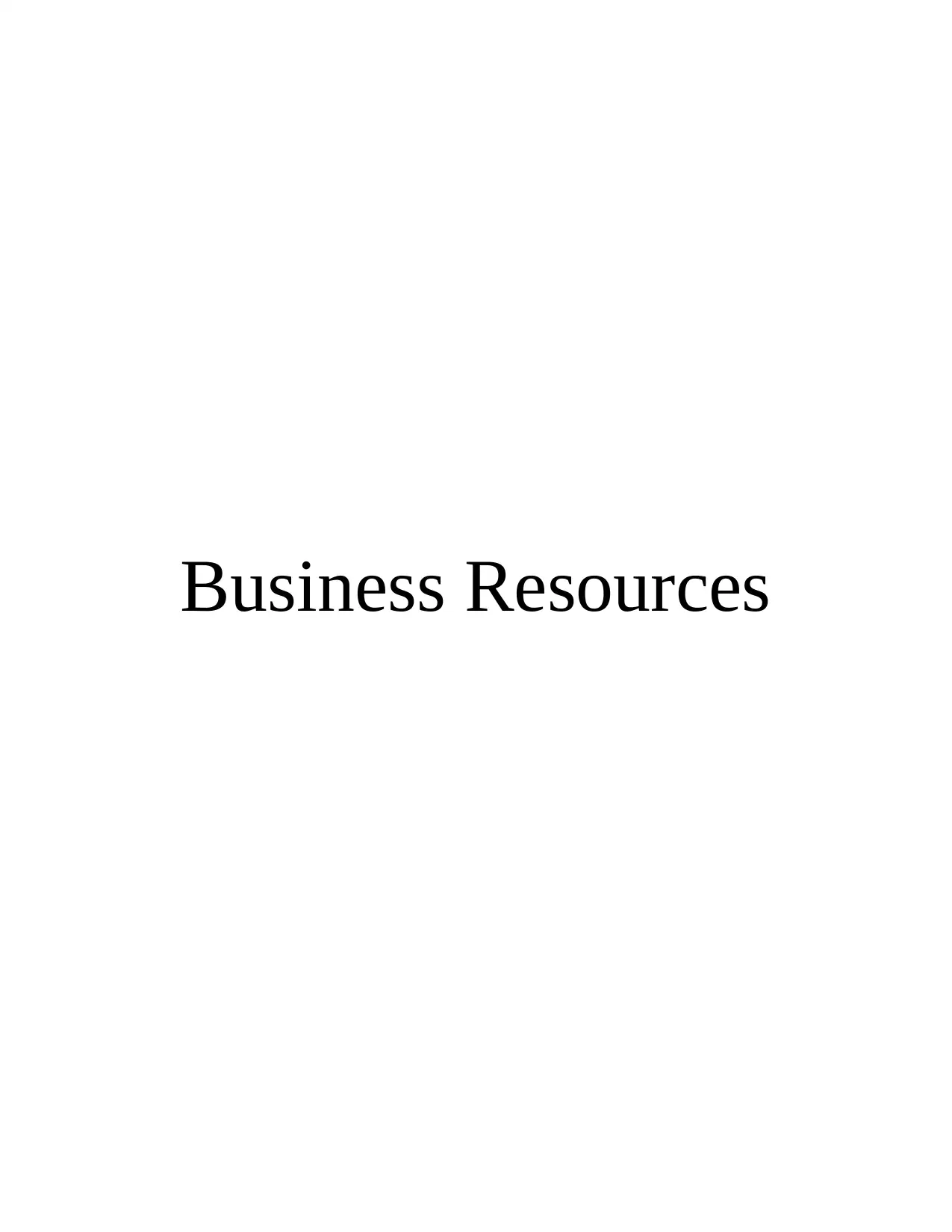
Business Resources
Paraphrase This Document
Need a fresh take? Get an instant paraphrase of this document with our AI Paraphraser
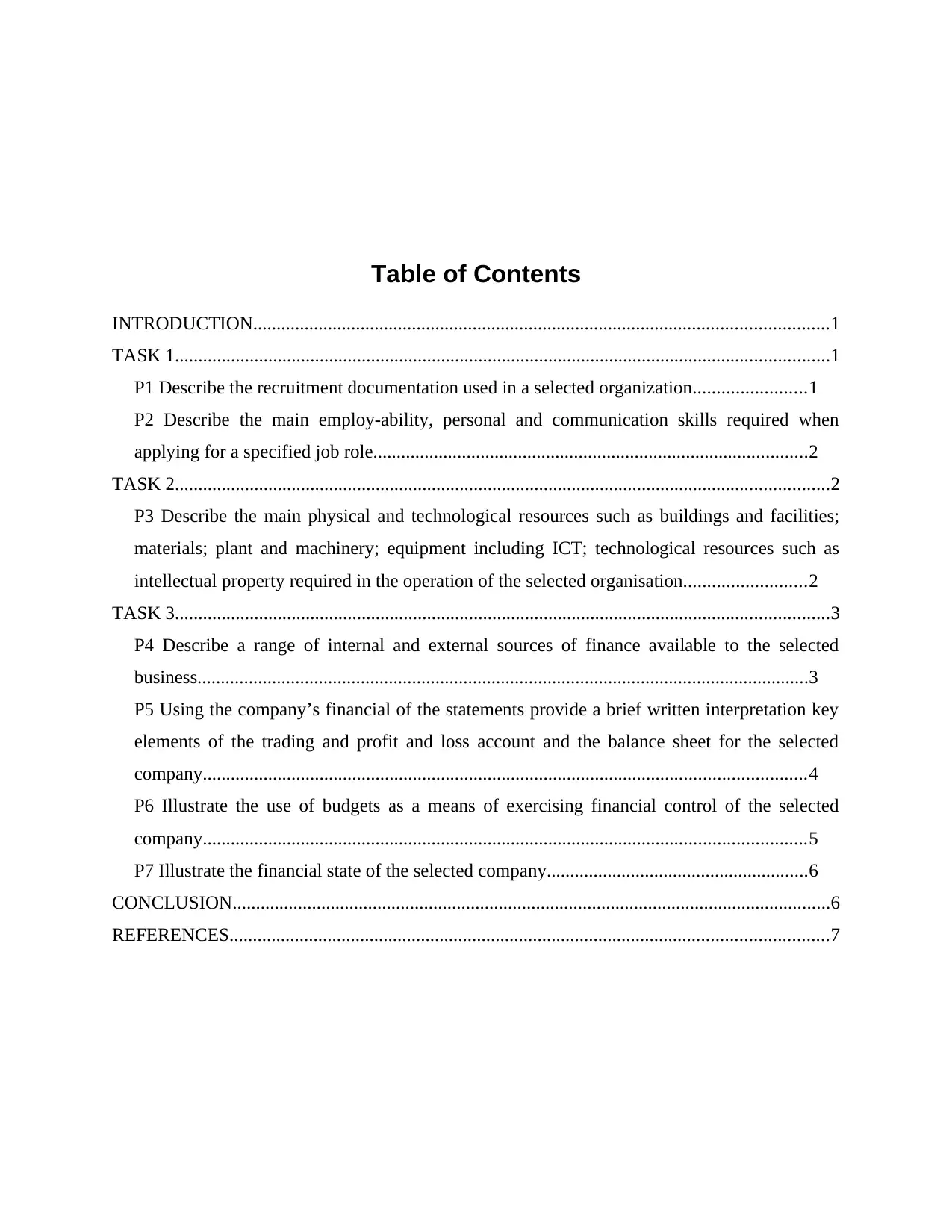
Table of Contents
INTRODUCTION...........................................................................................................................1
TASK 1............................................................................................................................................1
P1 Describe the recruitment documentation used in a selected organization........................1
P2 Describe the main employ-ability, personal and communication skills required when
applying for a specified job role.............................................................................................2
TASK 2............................................................................................................................................2
P3 Describe the main physical and technological resources such as buildings and facilities;
materials; plant and machinery; equipment including ICT; technological resources such as
intellectual property required in the operation of the selected organisation..........................2
TASK 3............................................................................................................................................3
P4 Describe a range of internal and external sources of finance available to the selected
business...................................................................................................................................3
P5 Using the company’s financial of the statements provide a brief written interpretation key
elements of the trading and profit and loss account and the balance sheet for the selected
company.................................................................................................................................4
P6 Illustrate the use of budgets as a means of exercising financial control of the selected
company.................................................................................................................................5
P7 Illustrate the financial state of the selected company........................................................6
CONCLUSION................................................................................................................................6
REFERENCES................................................................................................................................7
INTRODUCTION...........................................................................................................................1
TASK 1............................................................................................................................................1
P1 Describe the recruitment documentation used in a selected organization........................1
P2 Describe the main employ-ability, personal and communication skills required when
applying for a specified job role.............................................................................................2
TASK 2............................................................................................................................................2
P3 Describe the main physical and technological resources such as buildings and facilities;
materials; plant and machinery; equipment including ICT; technological resources such as
intellectual property required in the operation of the selected organisation..........................2
TASK 3............................................................................................................................................3
P4 Describe a range of internal and external sources of finance available to the selected
business...................................................................................................................................3
P5 Using the company’s financial of the statements provide a brief written interpretation key
elements of the trading and profit and loss account and the balance sheet for the selected
company.................................................................................................................................4
P6 Illustrate the use of budgets as a means of exercising financial control of the selected
company.................................................................................................................................5
P7 Illustrate the financial state of the selected company........................................................6
CONCLUSION................................................................................................................................6
REFERENCES................................................................................................................................7

⊘ This is a preview!⊘
Do you want full access?
Subscribe today to unlock all pages.

Trusted by 1+ million students worldwide
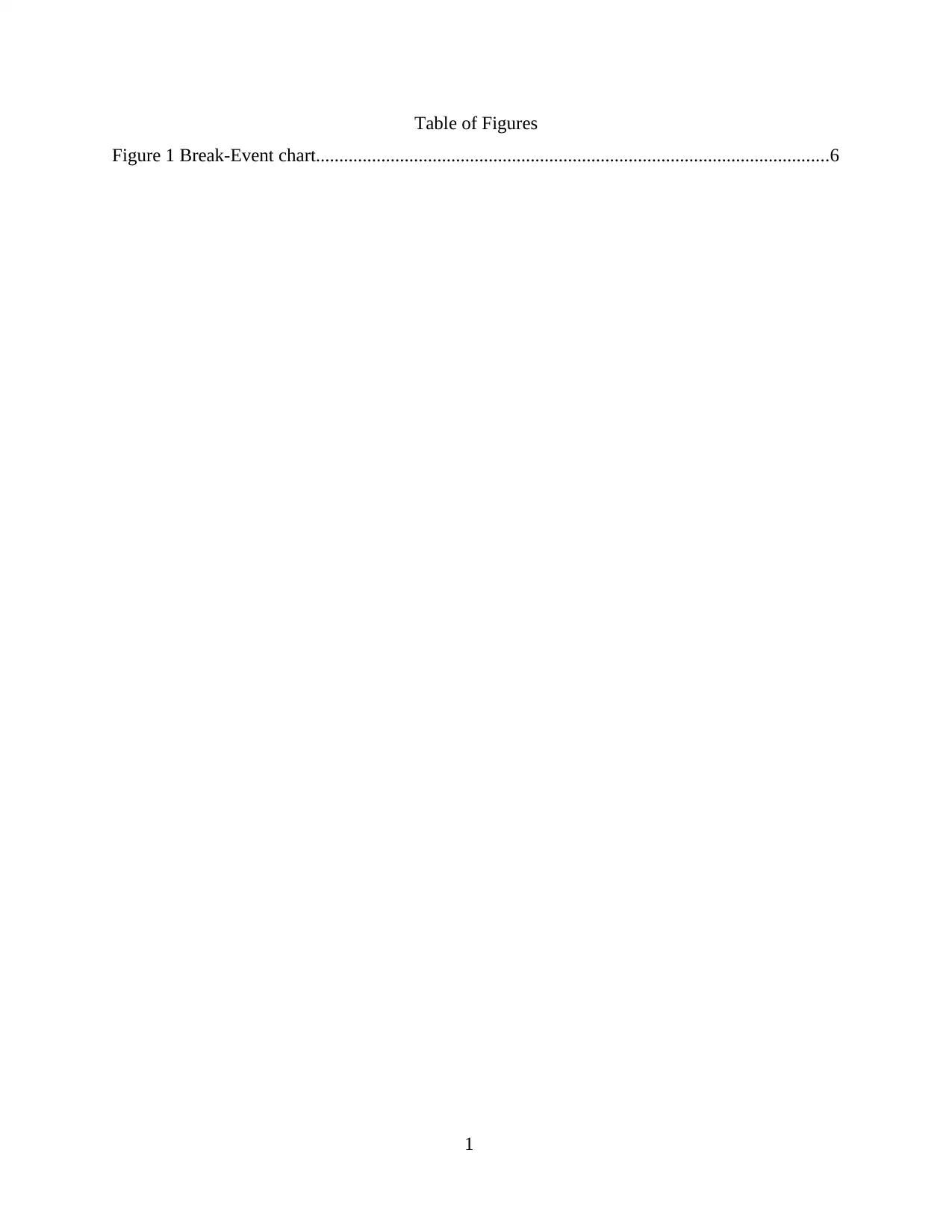
Table of Figures
Figure 1 Break-Event chart..............................................................................................................6
1
Figure 1 Break-Event chart..............................................................................................................6
1
Paraphrase This Document
Need a fresh take? Get an instant paraphrase of this document with our AI Paraphraser

INTRODUCTION
Business resources are composition of financial, production and distribution of goods and
HR activities. However, Different operations are obtained that is interlinked with varieties of
services for implementing action plans. Human, financial, physical, and knowledge factors that
provide a firm the means to perform its business processes. The present report is to presenting
recruitment documentation and different skills required for a specific job is to described. In
addition to this, physical and technological resources required in the operation of Asda are to be
explained through this study. Including this, financial state of business organization can be
understood through this assignment.
TASK 1
P1 Describe the recruitment documentation used in a selected organization
Asda is one of the world’s most well known and valuable brands and commands a
leading market share in the world’s supermarket business. Asda produces food and general
household products and it also has a cafeteria McCafe which produces hot drinks, sweets and
snacks. The restaurant employs about 130 people (Singh, 2012). Documentation used by HR
manager of Asda is as follows
Job Description: It sets out the purpose of a job, where the job fits into the organisation
structure, the main responsibilities of the job and the key tasks to be performed. A job
description will set out how a particular employee will fit into the organization. It will therefore
need to set out:the title of the job to whom the employee is responsible for whom the employee is
responsible simple description of the role and duties of the employee within the organization.
Person Specification: It is a profile of the ideal candidate for the job. It enables potential
candidate to determine whether they meet the required experience and qualifications. It also
helps employees to identify requirements for the job. A person specification will help during
interviews and it will also help to be used as a basis for staff development, appraisals and
promotions. The person specification details the necessary skills, qualifications, experience or
other attributes needed to carry out the job (Stahel, 2016).
Application Form: An application form sets out information on a candidate in standard
format. It provides a structured basis or drawing up shortlists, the interview itself and the
following actions required in offering an employment and in setting personnel records.
1
Business resources are composition of financial, production and distribution of goods and
HR activities. However, Different operations are obtained that is interlinked with varieties of
services for implementing action plans. Human, financial, physical, and knowledge factors that
provide a firm the means to perform its business processes. The present report is to presenting
recruitment documentation and different skills required for a specific job is to described. In
addition to this, physical and technological resources required in the operation of Asda are to be
explained through this study. Including this, financial state of business organization can be
understood through this assignment.
TASK 1
P1 Describe the recruitment documentation used in a selected organization
Asda is one of the world’s most well known and valuable brands and commands a
leading market share in the world’s supermarket business. Asda produces food and general
household products and it also has a cafeteria McCafe which produces hot drinks, sweets and
snacks. The restaurant employs about 130 people (Singh, 2012). Documentation used by HR
manager of Asda is as follows
Job Description: It sets out the purpose of a job, where the job fits into the organisation
structure, the main responsibilities of the job and the key tasks to be performed. A job
description will set out how a particular employee will fit into the organization. It will therefore
need to set out:the title of the job to whom the employee is responsible for whom the employee is
responsible simple description of the role and duties of the employee within the organization.
Person Specification: It is a profile of the ideal candidate for the job. It enables potential
candidate to determine whether they meet the required experience and qualifications. It also
helps employees to identify requirements for the job. A person specification will help during
interviews and it will also help to be used as a basis for staff development, appraisals and
promotions. The person specification details the necessary skills, qualifications, experience or
other attributes needed to carry out the job (Stahel, 2016).
Application Form: An application form sets out information on a candidate in standard
format. It provides a structured basis or drawing up shortlists, the interview itself and the
following actions required in offering an employment and in setting personnel records.
1

P2 Describe the main employ-ability, personal and communication skills required when applying
for a specified job role.
Employ ability skills: It implies the capacity of somebody to pick up a vocation, hold it
and the process onward to a higher stage in their working life. Employ ability is enhanced by
solid individual and correspondences aptitudes which will inspire a potential boss. There are
numerous abilities and capabilities required when applying for an occupation. Bosses will tend to
search for how satisfactory the employee on the off chance that they can impart plainly and for
the off chance that they can get on well with existing workers. They will likewise need aptitudes
and capabilities which are significant to the employment you’re applying for. Asda will need to
see that the abilities of the potential enlisted person meet the requests of the occupation and will
advantage the business.
Personal Skills: Personal skills can be defined as a skill that a person may possess but
doesn’t necessarily need when applying for a specific job. There are many examples of such
skills which would benefited Asda which includes; speaking different languages, trustworthy and
having a sense a humor. It is good if employees or applicants possess such skills when applying
for a job as it will make them more likely to get the job as it shows the employer other skills that
the employee/applicant have that can help the business; the skills are useful for a lot of different
jobs.
Communication Skills: Communication skills can be defined as a skill that help a person
convey information to another person efficiently and with ease. Managers or employees with
good written or verbal communication skills will benefit the business, this is because they will be
able to talk and understand each other properly.
TASK 2
P3 Describe the main physical and technological resources such as buildings and facilities;
materials; plant and machinery; equipment including ICT; technological resources such as
intellectual property required in the operation of the selected organisation
Physical resources: Resources that the Asda needs to keep up to carry its
activities. They mostly incorporate things like offices, structures, apparatus and that’s just the
beginning. These are resources that are accessible to a business’ associations in the type of
structures and different apparatuses required for the everyday running of the association.
2
for a specified job role.
Employ ability skills: It implies the capacity of somebody to pick up a vocation, hold it
and the process onward to a higher stage in their working life. Employ ability is enhanced by
solid individual and correspondences aptitudes which will inspire a potential boss. There are
numerous abilities and capabilities required when applying for an occupation. Bosses will tend to
search for how satisfactory the employee on the off chance that they can impart plainly and for
the off chance that they can get on well with existing workers. They will likewise need aptitudes
and capabilities which are significant to the employment you’re applying for. Asda will need to
see that the abilities of the potential enlisted person meet the requests of the occupation and will
advantage the business.
Personal Skills: Personal skills can be defined as a skill that a person may possess but
doesn’t necessarily need when applying for a specific job. There are many examples of such
skills which would benefited Asda which includes; speaking different languages, trustworthy and
having a sense a humor. It is good if employees or applicants possess such skills when applying
for a job as it will make them more likely to get the job as it shows the employer other skills that
the employee/applicant have that can help the business; the skills are useful for a lot of different
jobs.
Communication Skills: Communication skills can be defined as a skill that help a person
convey information to another person efficiently and with ease. Managers or employees with
good written or verbal communication skills will benefit the business, this is because they will be
able to talk and understand each other properly.
TASK 2
P3 Describe the main physical and technological resources such as buildings and facilities;
materials; plant and machinery; equipment including ICT; technological resources such as
intellectual property required in the operation of the selected organisation
Physical resources: Resources that the Asda needs to keep up to carry its
activities. They mostly incorporate things like offices, structures, apparatus and that’s just the
beginning. These are resources that are accessible to a business’ associations in the type of
structures and different apparatuses required for the everyday running of the association.
2
⊘ This is a preview!⊘
Do you want full access?
Subscribe today to unlock all pages.

Trusted by 1+ million students worldwide
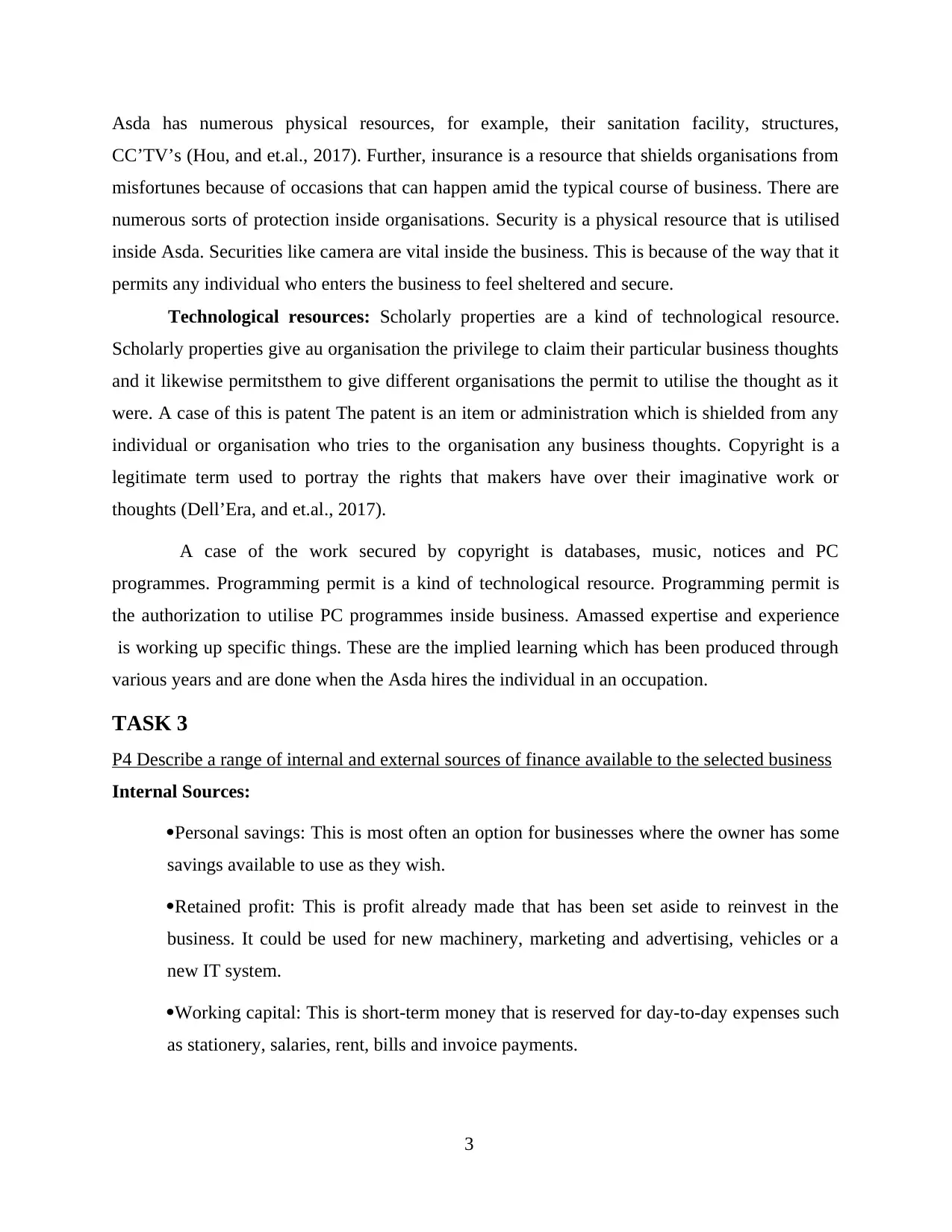
Asda has numerous physical resources, for example, their sanitation facility, structures,
CC’TV’s (Hou, and et.al., 2017). Further, insurance is a resource that shields organisations from
misfortunes because of occasions that can happen amid the typical course of business. There are
numerous sorts of protection inside organisations. Security is a physical resource that is utilised
inside Asda. Securities like camera are vital inside the business. This is because of the way that it
permits any individual who enters the business to feel sheltered and secure.
Technological resources: Scholarly properties are a kind of technological resource.
Scholarly properties give au organisation the privilege to claim their particular business thoughts
and it likewise permitsthem to give different organisations the permit to utilise the thought as it
were. A case of this is patent The patent is an item or administration which is shielded from any
individual or organisation who tries to the organisation any business thoughts. Copyright is a
legitimate term used to portray the rights that makers have over their imaginative work or
thoughts (Dell’Era, and et.al., 2017).
A case of the work secured by copyright is databases, music, notices and PC
programmes. Programming permit is a kind of technological resource. Programming permit is
the authorization to utilise PC programmes inside business. Amassed expertise and experience
is working up specific things. These are the implied learning which has been produced through
various years and are done when the Asda hires the individual in an occupation.
TASK 3
P4 Describe a range of internal and external sources of finance available to the selected business
Internal Sources:
Personal savings: This is most often an option for businesses where the owner has some
savings available to use as they wish.
Retained profit: This is profit already made that has been set aside to reinvest in the
business. It could be used for new machinery, marketing and advertising, vehicles or a
new IT system.
Working capital: This is short-term money that is reserved for day-to-day expenses such
as stationery, salaries, rent, bills and invoice payments.
3
CC’TV’s (Hou, and et.al., 2017). Further, insurance is a resource that shields organisations from
misfortunes because of occasions that can happen amid the typical course of business. There are
numerous sorts of protection inside organisations. Security is a physical resource that is utilised
inside Asda. Securities like camera are vital inside the business. This is because of the way that it
permits any individual who enters the business to feel sheltered and secure.
Technological resources: Scholarly properties are a kind of technological resource.
Scholarly properties give au organisation the privilege to claim their particular business thoughts
and it likewise permitsthem to give different organisations the permit to utilise the thought as it
were. A case of this is patent The patent is an item or administration which is shielded from any
individual or organisation who tries to the organisation any business thoughts. Copyright is a
legitimate term used to portray the rights that makers have over their imaginative work or
thoughts (Dell’Era, and et.al., 2017).
A case of the work secured by copyright is databases, music, notices and PC
programmes. Programming permit is a kind of technological resource. Programming permit is
the authorization to utilise PC programmes inside business. Amassed expertise and experience
is working up specific things. These are the implied learning which has been produced through
various years and are done when the Asda hires the individual in an occupation.
TASK 3
P4 Describe a range of internal and external sources of finance available to the selected business
Internal Sources:
Personal savings: This is most often an option for businesses where the owner has some
savings available to use as they wish.
Retained profit: This is profit already made that has been set aside to reinvest in the
business. It could be used for new machinery, marketing and advertising, vehicles or a
new IT system.
Working capital: This is short-term money that is reserved for day-to-day expenses such
as stationery, salaries, rent, bills and invoice payments.
3
Paraphrase This Document
Need a fresh take? Get an instant paraphrase of this document with our AI Paraphraser
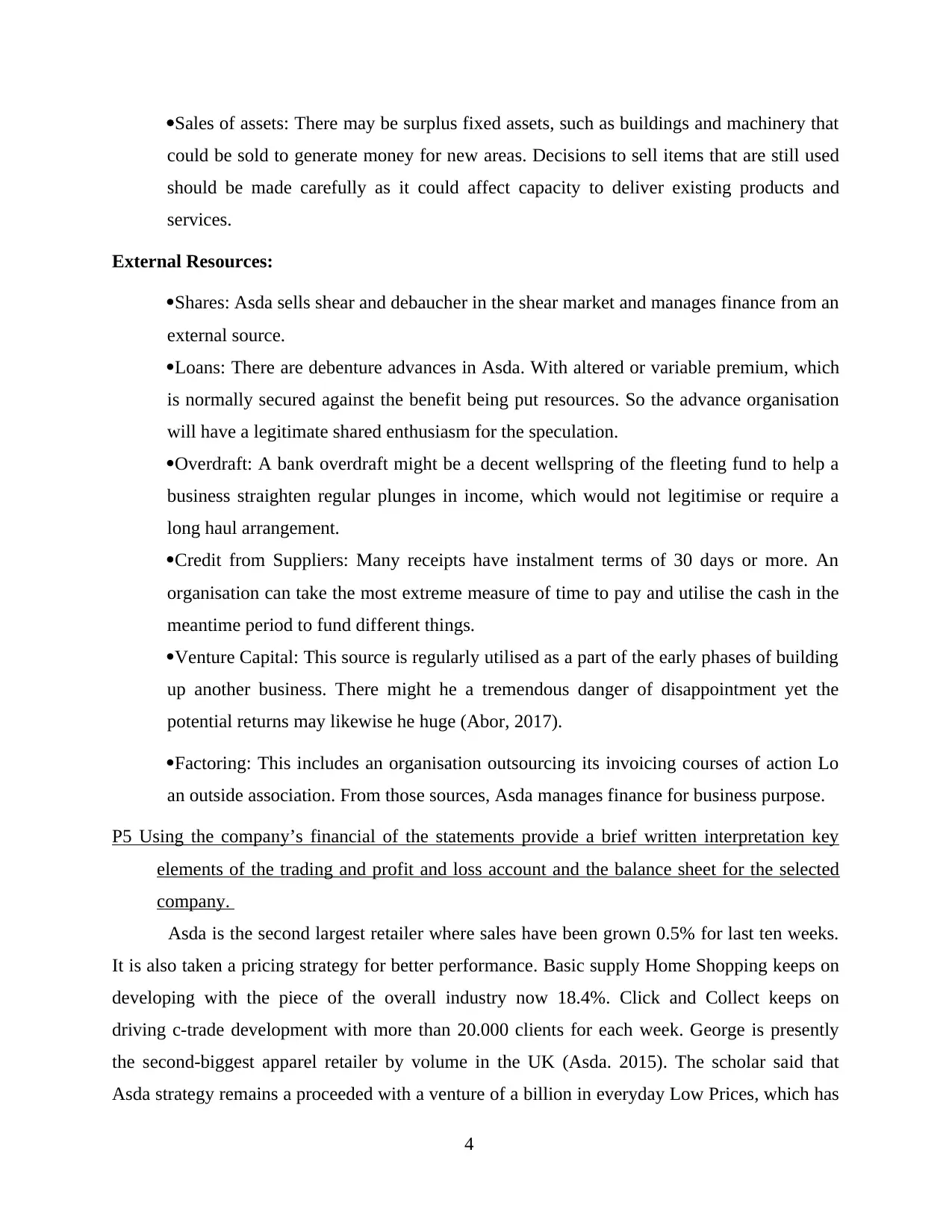
Sales of assets: There may be surplus fixed assets, such as buildings and machinery that
could be sold to generate money for new areas. Decisions to sell items that are still used
should be made carefully as it could affect capacity to deliver existing products and
services.
External Resources:
Shares: Asda sells shear and debaucher in the shear market and manages finance from an
external source.
Loans: There are debenture advances in Asda. With altered or variable premium, which
is normally secured against the benefit being put resources. So the advance organisation
will have a legitimate shared enthusiasm for the speculation.
Overdraft: A bank overdraft might be a decent wellspring of the fleeting fund to help a
business straighten regular plunges in income, which would not legitimise or require a
long haul arrangement.
Credit from Suppliers: Many receipts have instalment terms of 30 days or more. An
organisation can take the most extreme measure of time to pay and utilise the cash in the
meantime period to fund different things.
Venture Capital: This source is regularly utilised as a part of the early phases of building
up another business. There might he a tremendous danger of disappointment yet the
potential returns may likewise he huge (Abor, 2017).
Factoring: This includes an organisation outsourcing its invoicing courses of action Lo
an outside association. From those sources, Asda manages finance for business purpose.
P5 Using the company’s financial of the statements provide a brief written interpretation key
elements of the trading and profit and loss account and the balance sheet for the selected
company.
Asda is the second largest retailer where sales have been grown 0.5% for last ten weeks.
It is also taken a pricing strategy for better performance. Basic supply Home Shopping keeps on
developing with the piece of the overall industry now 18.4%. Click and Collect keeps on
driving c-trade development with more than 20.000 clients for each week. George is presently
the second-biggest apparel retailer by volume in the UK (Asda. 2015). The scholar said that
Asda strategy remains a proceeded with a venture of a billion in everyday Low Prices, which has
4
could be sold to generate money for new areas. Decisions to sell items that are still used
should be made carefully as it could affect capacity to deliver existing products and
services.
External Resources:
Shares: Asda sells shear and debaucher in the shear market and manages finance from an
external source.
Loans: There are debenture advances in Asda. With altered or variable premium, which
is normally secured against the benefit being put resources. So the advance organisation
will have a legitimate shared enthusiasm for the speculation.
Overdraft: A bank overdraft might be a decent wellspring of the fleeting fund to help a
business straighten regular plunges in income, which would not legitimise or require a
long haul arrangement.
Credit from Suppliers: Many receipts have instalment terms of 30 days or more. An
organisation can take the most extreme measure of time to pay and utilise the cash in the
meantime period to fund different things.
Venture Capital: This source is regularly utilised as a part of the early phases of building
up another business. There might he a tremendous danger of disappointment yet the
potential returns may likewise he huge (Abor, 2017).
Factoring: This includes an organisation outsourcing its invoicing courses of action Lo
an outside association. From those sources, Asda manages finance for business purpose.
P5 Using the company’s financial of the statements provide a brief written interpretation key
elements of the trading and profit and loss account and the balance sheet for the selected
company.
Asda is the second largest retailer where sales have been grown 0.5% for last ten weeks.
It is also taken a pricing strategy for better performance. Basic supply Home Shopping keeps on
developing with the piece of the overall industry now 18.4%. Click and Collect keeps on
driving c-trade development with more than 20.000 clients for each week. George is presently
the second-biggest apparel retailer by volume in the UK (Asda. 2015). The scholar said that
Asda strategy remains a proceeded with a venture of a billion in everyday Low Prices, which has
4

been at the centre of the business for quite a long time. Asda kept up a solid value crevice Lo
whatever is left of the Big 4 amid the quarter and stretched out Price Lock to 160 lines. This is
the unmonitored costs and budgets in Asda. The strategy is responsible for falling in
unmonitored costs and budgets cost problem.
P6 Illustrate the use of budgets as a means of exercising financial control of the selected
company.
Budget is a summary of likely income and expenses for a given period. It helps
company determine whether management can grab that bite to eat or should head home for a
bowl of soup. It is typically created using a spreadsheet, and it provides a concrete, organized,
and easily understood breakdown of how much money you have coming in and how much you
are letting go. It’s an invaluable tool to help you prioritize your spending and manage money—
no matter how much or how little company have. Budgets are used so people can give
themselves a spending limit whether this to save up some money for something in the future or
they are splashing out on something like a new mobile phone or a car – then they will give
themselves a limit so they don’t spend too much money.
There are two main costs that you need to manage to budget: fixed costs and variable costs
(Pacheco, López, and Marín-Raventós, 2016).
Fixed costs won’t change, regardless of the number of goods that are sold or services that are
offered. These costs include insurance, rent and salaries. It doesn’t matter how much money
make’s they still need to pay these costs.
Variable costs change according to output. These costs change directly according how
many products are made.
Break-even chart
5
whatever is left of the Big 4 amid the quarter and stretched out Price Lock to 160 lines. This is
the unmonitored costs and budgets in Asda. The strategy is responsible for falling in
unmonitored costs and budgets cost problem.
P6 Illustrate the use of budgets as a means of exercising financial control of the selected
company.
Budget is a summary of likely income and expenses for a given period. It helps
company determine whether management can grab that bite to eat or should head home for a
bowl of soup. It is typically created using a spreadsheet, and it provides a concrete, organized,
and easily understood breakdown of how much money you have coming in and how much you
are letting go. It’s an invaluable tool to help you prioritize your spending and manage money—
no matter how much or how little company have. Budgets are used so people can give
themselves a spending limit whether this to save up some money for something in the future or
they are splashing out on something like a new mobile phone or a car – then they will give
themselves a limit so they don’t spend too much money.
There are two main costs that you need to manage to budget: fixed costs and variable costs
(Pacheco, López, and Marín-Raventós, 2016).
Fixed costs won’t change, regardless of the number of goods that are sold or services that are
offered. These costs include insurance, rent and salaries. It doesn’t matter how much money
make’s they still need to pay these costs.
Variable costs change according to output. These costs change directly according how
many products are made.
Break-even chart
5
⊘ This is a preview!⊘
Do you want full access?
Subscribe today to unlock all pages.

Trusted by 1+ million students worldwide
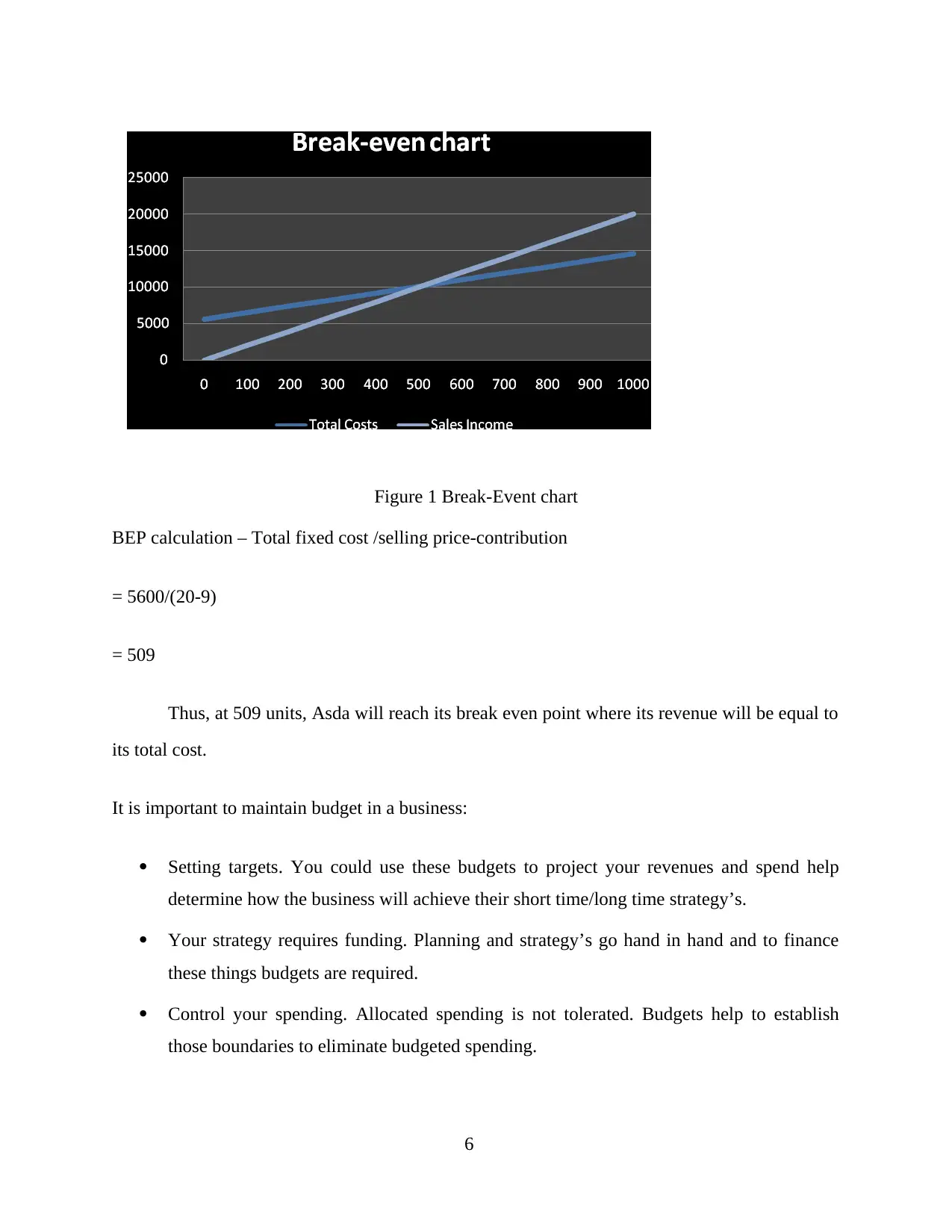
Figure 1 Break-Event chart
BEP calculation – Total fixed cost /selling price-contribution
= 5600/(20-9)
= 509
Thus, at 509 units, Asda will reach its break even point where its revenue will be equal to
its total cost.
It is important to maintain budget in a business:
Setting targets. You could use these budgets to project your revenues and spend help
determine how the business will achieve their short time/long time strategy’s.
Your strategy requires funding. Planning and strategy’s go hand in hand and to finance
these things budgets are required.
Control your spending. Allocated spending is not tolerated. Budgets help to establish
those boundaries to eliminate budgeted spending.
6
BEP calculation – Total fixed cost /selling price-contribution
= 5600/(20-9)
= 509
Thus, at 509 units, Asda will reach its break even point where its revenue will be equal to
its total cost.
It is important to maintain budget in a business:
Setting targets. You could use these budgets to project your revenues and spend help
determine how the business will achieve their short time/long time strategy’s.
Your strategy requires funding. Planning and strategy’s go hand in hand and to finance
these things budgets are required.
Control your spending. Allocated spending is not tolerated. Budgets help to establish
those boundaries to eliminate budgeted spending.
6
Paraphrase This Document
Need a fresh take? Get an instant paraphrase of this document with our AI Paraphraser

It provides a profit margin. These things provide a resource what you can then reinvest
back into the business. This way companies can grow. Budgeting for a profit margin
helps in making Asda future plans.
P7 Illustrate the financial state of the selected company
Solvency
Using figure 1 (below) I can figure out solvency for Asda in 2014, the current ratio is 1.42:1. A
ratio between 1.5:1 and 2:1 is desirable, but 1.42:1 is close and it means that if Asda needed to
pay off all its liabilities they could do so by selling their assets and still have the 0.42 of assets
left over.
Profitability
Profitability can be figured out using a formula, there are three main ones — gross profit
percentage, net profit percentage and return of capital employed using figure 1 I can figure out
the gross profit percentage and net profit percentage which is 6.31% and 1.53% respectively,
these are both low and probably due to the intense competition that Asda has as they are always
having to lower their prices.
Performance:
Performance can be measured by calculating stock turnover, using figure 1 and 2 the stock
turnover is 27.19 number of times which means it takes 27.19 days for the stock to be sold
(Kamsu-Foguem, and Tiako, 2017).
CONCLUSION
The report is concluded that adequate allocation of business resources can be gained
through analyzing actual performance of entity. Including this, different tools and techniques for
increasing productivity and profitability is presented that affects on its goodwill. However,
significance of budget for forecasting and decision making is obtained for effectiveness of firm
at high level. Including this, financial statement analysis is presented to generate varieties of
ideas for better quality services effectively.
7
back into the business. This way companies can grow. Budgeting for a profit margin
helps in making Asda future plans.
P7 Illustrate the financial state of the selected company
Solvency
Using figure 1 (below) I can figure out solvency for Asda in 2014, the current ratio is 1.42:1. A
ratio between 1.5:1 and 2:1 is desirable, but 1.42:1 is close and it means that if Asda needed to
pay off all its liabilities they could do so by selling their assets and still have the 0.42 of assets
left over.
Profitability
Profitability can be figured out using a formula, there are three main ones — gross profit
percentage, net profit percentage and return of capital employed using figure 1 I can figure out
the gross profit percentage and net profit percentage which is 6.31% and 1.53% respectively,
these are both low and probably due to the intense competition that Asda has as they are always
having to lower their prices.
Performance:
Performance can be measured by calculating stock turnover, using figure 1 and 2 the stock
turnover is 27.19 number of times which means it takes 27.19 days for the stock to be sold
(Kamsu-Foguem, and Tiako, 2017).
CONCLUSION
The report is concluded that adequate allocation of business resources can be gained
through analyzing actual performance of entity. Including this, different tools and techniques for
increasing productivity and profitability is presented that affects on its goodwill. However,
significance of budget for forecasting and decision making is obtained for effectiveness of firm
at high level. Including this, financial statement analysis is presented to generate varieties of
ideas for better quality services effectively.
7
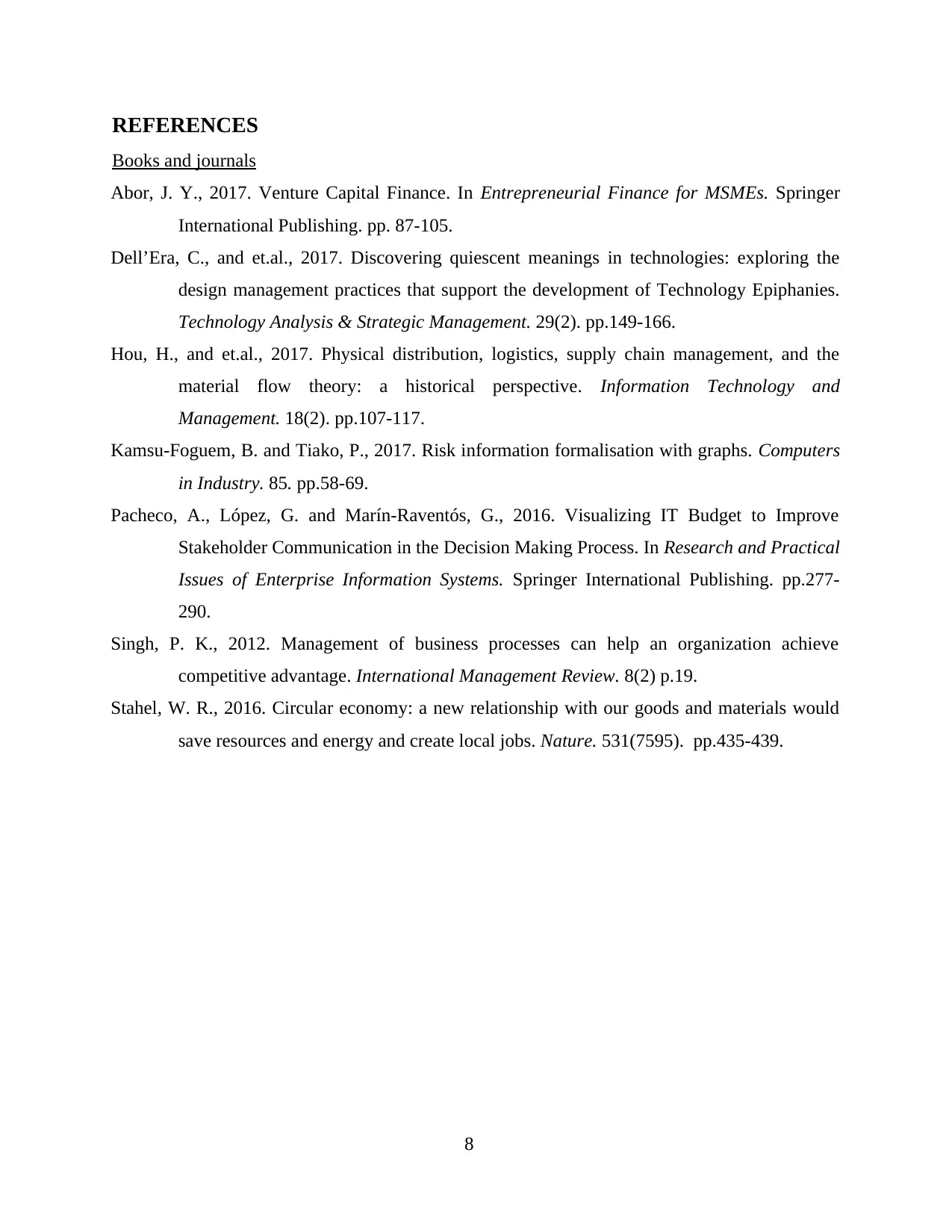
REFERENCES
Books and journals
Abor, J. Y., 2017. Venture Capital Finance. In Entrepreneurial Finance for MSMEs. Springer
International Publishing. pp. 87-105.
Dell’Era, C., and et.al., 2017. Discovering quiescent meanings in technologies: exploring the
design management practices that support the development of Technology Epiphanies.
Technology Analysis & Strategic Management. 29(2). pp.149-166.
Hou, H., and et.al., 2017. Physical distribution, logistics, supply chain management, and the
material flow theory: a historical perspective. Information Technology and
Management. 18(2). pp.107-117.
Kamsu-Foguem, B. and Tiako, P., 2017. Risk information formalisation with graphs. Computers
in Industry. 85. pp.58-69.
Pacheco, A., López, G. and Marín-Raventós, G., 2016. Visualizing IT Budget to Improve
Stakeholder Communication in the Decision Making Process. In Research and Practical
Issues of Enterprise Information Systems. Springer International Publishing. pp.277-
290.
Singh, P. K., 2012. Management of business processes can help an organization achieve
competitive advantage. International Management Review. 8(2) p.19.
Stahel, W. R., 2016. Circular economy: a new relationship with our goods and materials would
save resources and energy and create local jobs. Nature. 531(7595). pp.435-439.
8
Books and journals
Abor, J. Y., 2017. Venture Capital Finance. In Entrepreneurial Finance for MSMEs. Springer
International Publishing. pp. 87-105.
Dell’Era, C., and et.al., 2017. Discovering quiescent meanings in technologies: exploring the
design management practices that support the development of Technology Epiphanies.
Technology Analysis & Strategic Management. 29(2). pp.149-166.
Hou, H., and et.al., 2017. Physical distribution, logistics, supply chain management, and the
material flow theory: a historical perspective. Information Technology and
Management. 18(2). pp.107-117.
Kamsu-Foguem, B. and Tiako, P., 2017. Risk information formalisation with graphs. Computers
in Industry. 85. pp.58-69.
Pacheco, A., López, G. and Marín-Raventós, G., 2016. Visualizing IT Budget to Improve
Stakeholder Communication in the Decision Making Process. In Research and Practical
Issues of Enterprise Information Systems. Springer International Publishing. pp.277-
290.
Singh, P. K., 2012. Management of business processes can help an organization achieve
competitive advantage. International Management Review. 8(2) p.19.
Stahel, W. R., 2016. Circular economy: a new relationship with our goods and materials would
save resources and energy and create local jobs. Nature. 531(7595). pp.435-439.
8
⊘ This is a preview!⊘
Do you want full access?
Subscribe today to unlock all pages.

Trusted by 1+ million students worldwide
1 out of 12
Related Documents
Your All-in-One AI-Powered Toolkit for Academic Success.
+13062052269
info@desklib.com
Available 24*7 on WhatsApp / Email
![[object Object]](/_next/static/media/star-bottom.7253800d.svg)
Unlock your academic potential
Copyright © 2020–2025 A2Z Services. All Rights Reserved. Developed and managed by ZUCOL.





